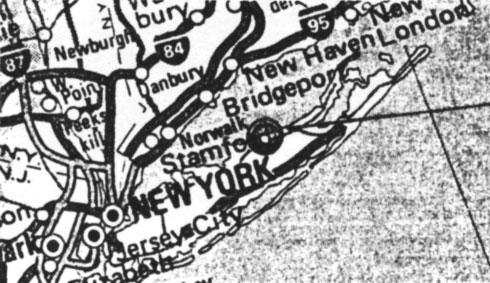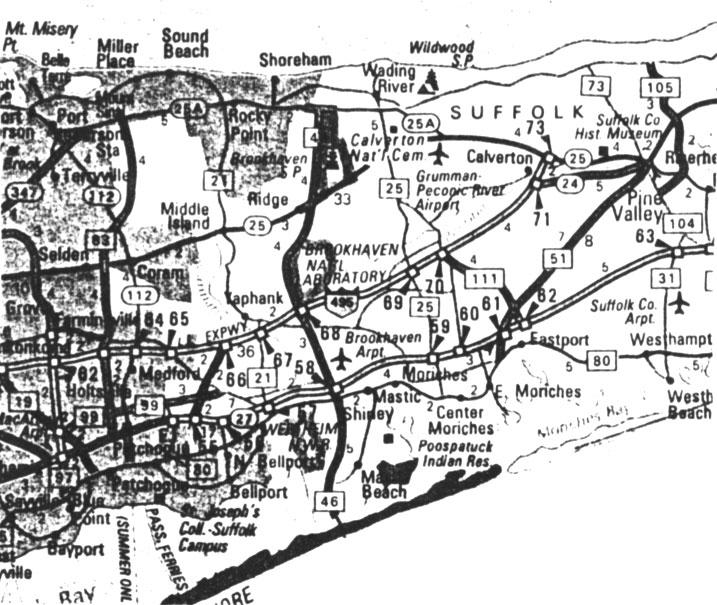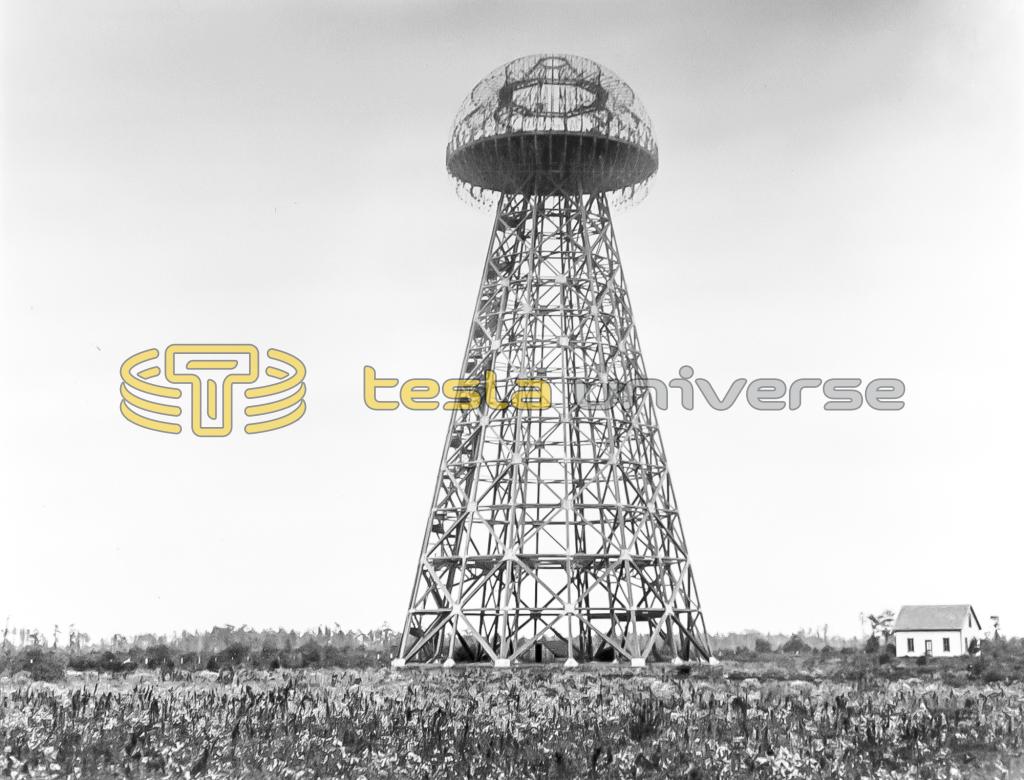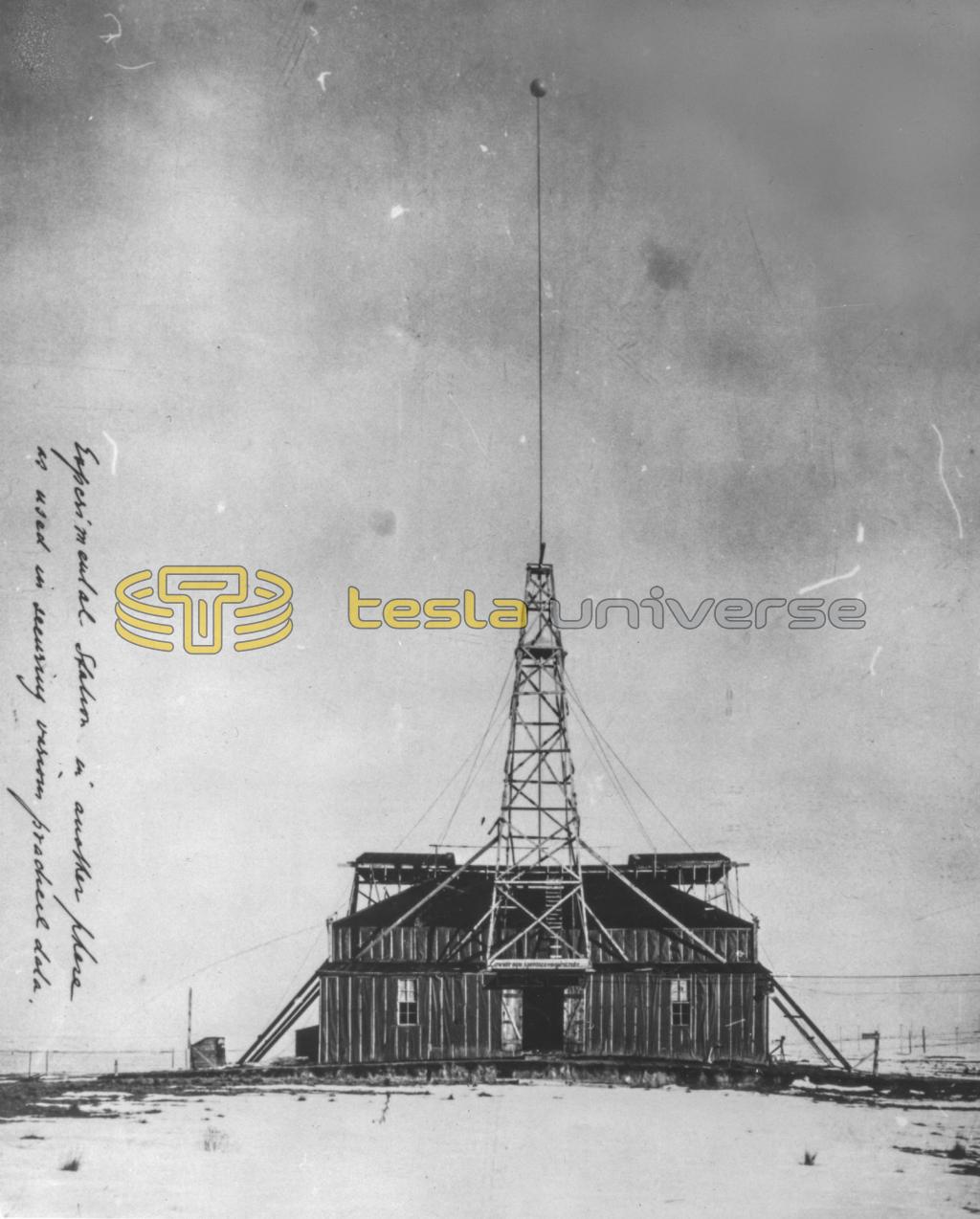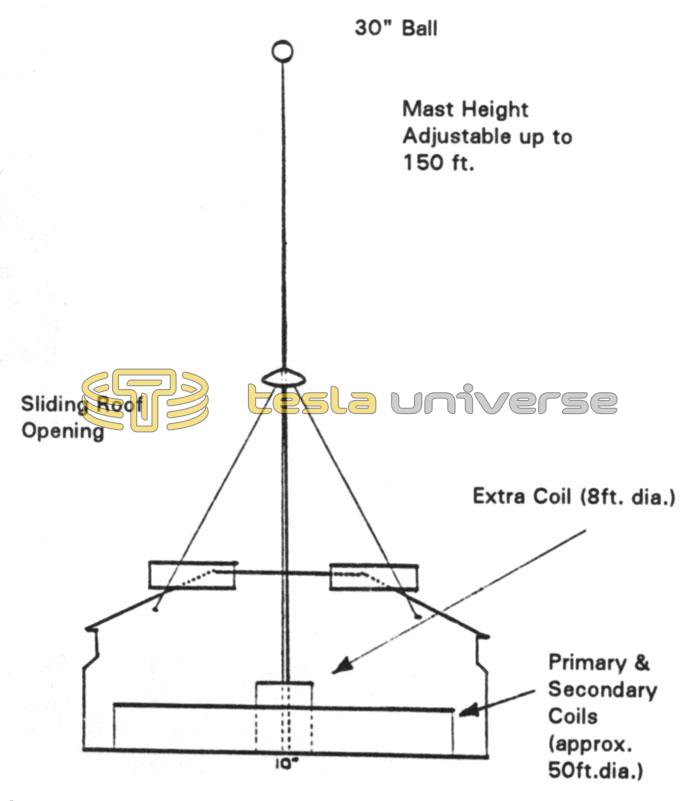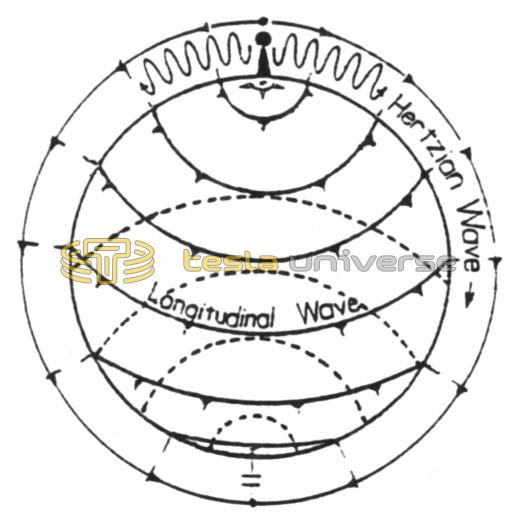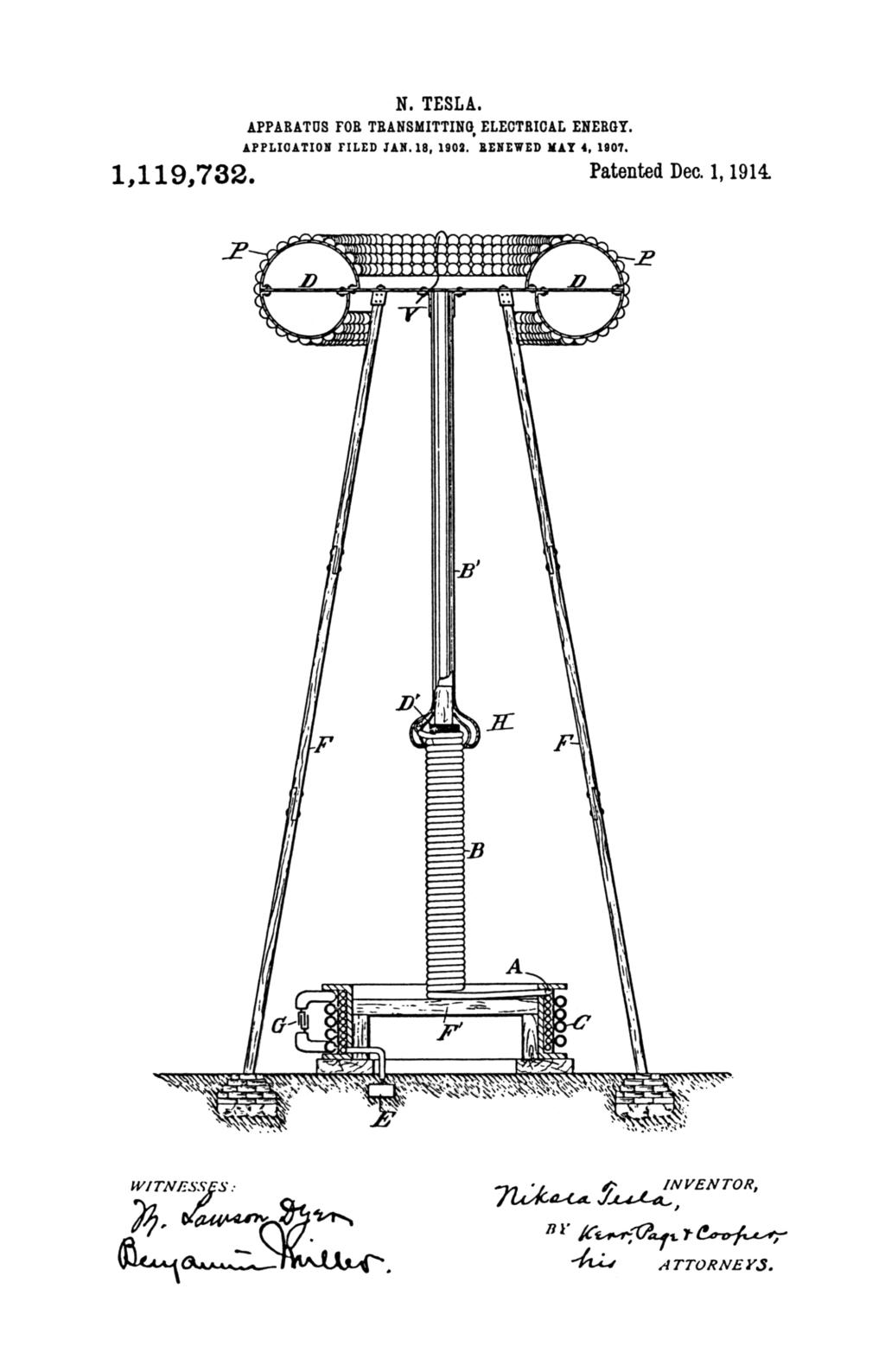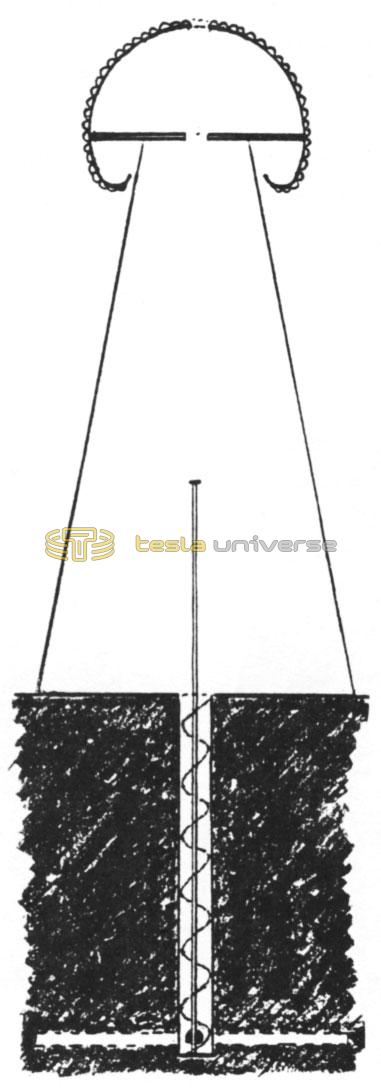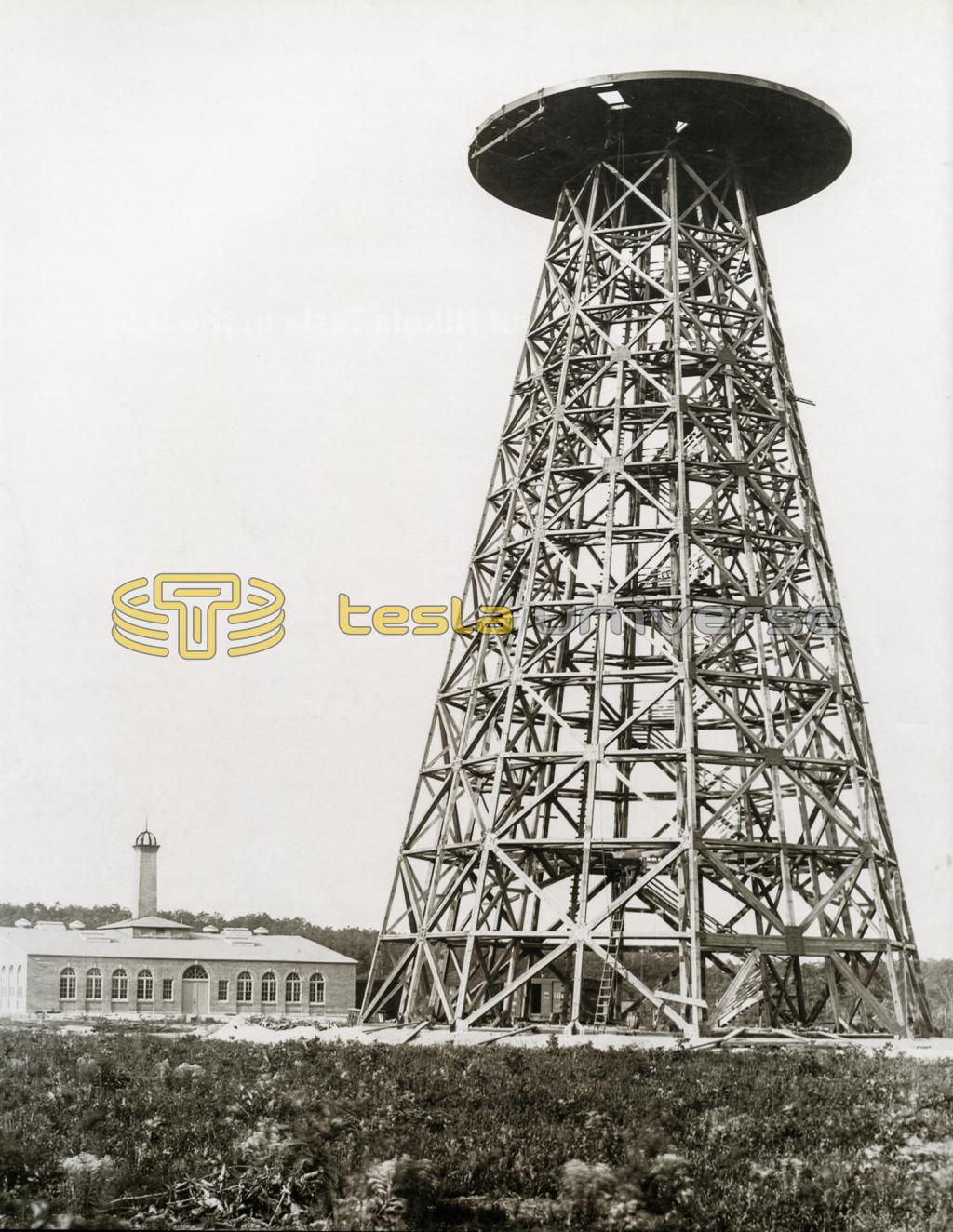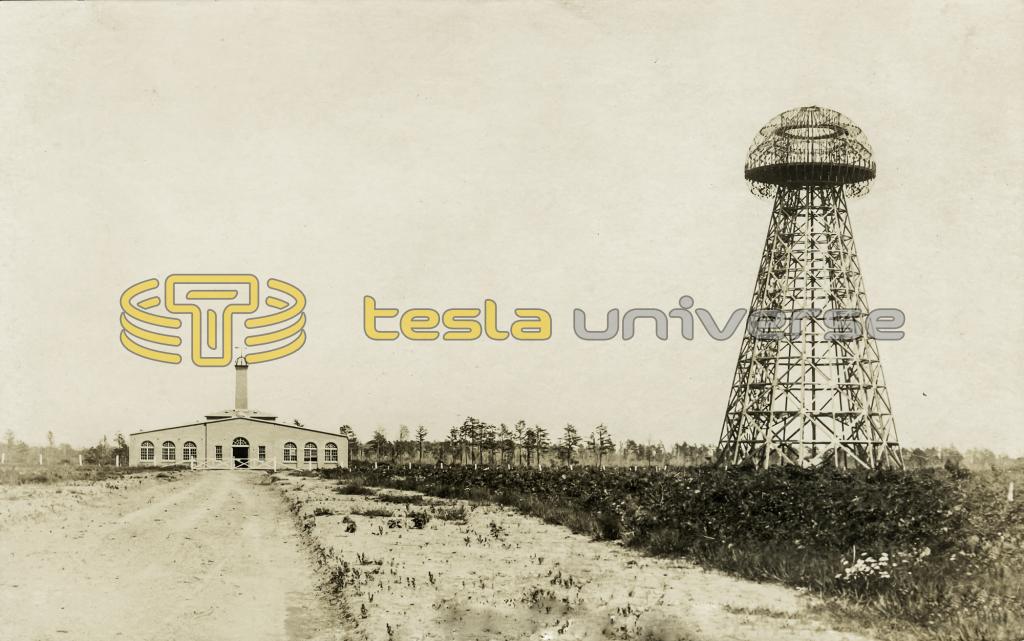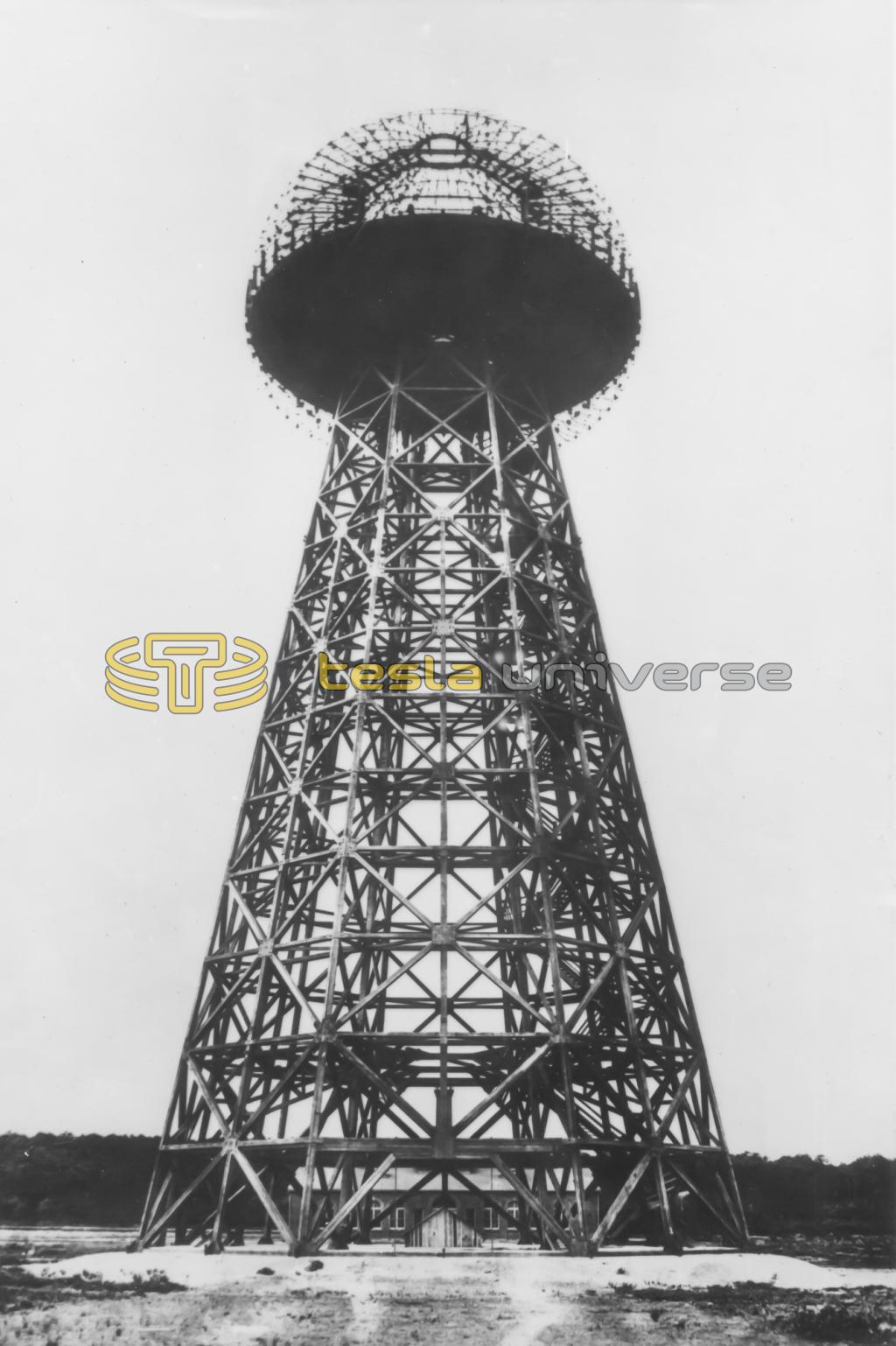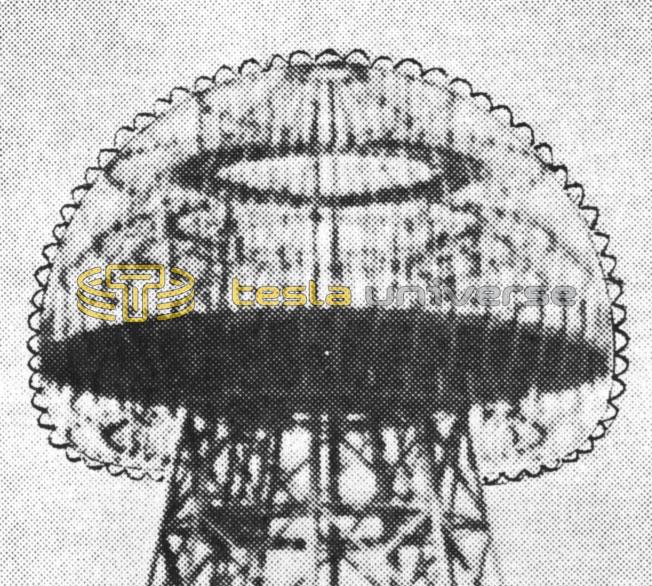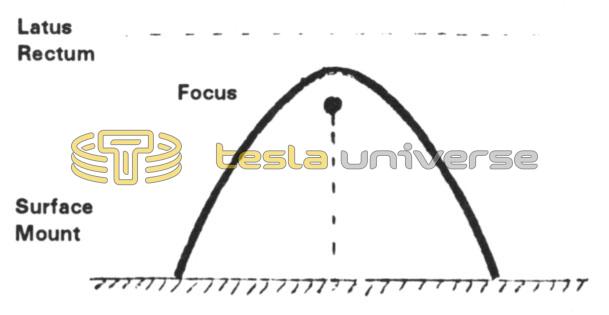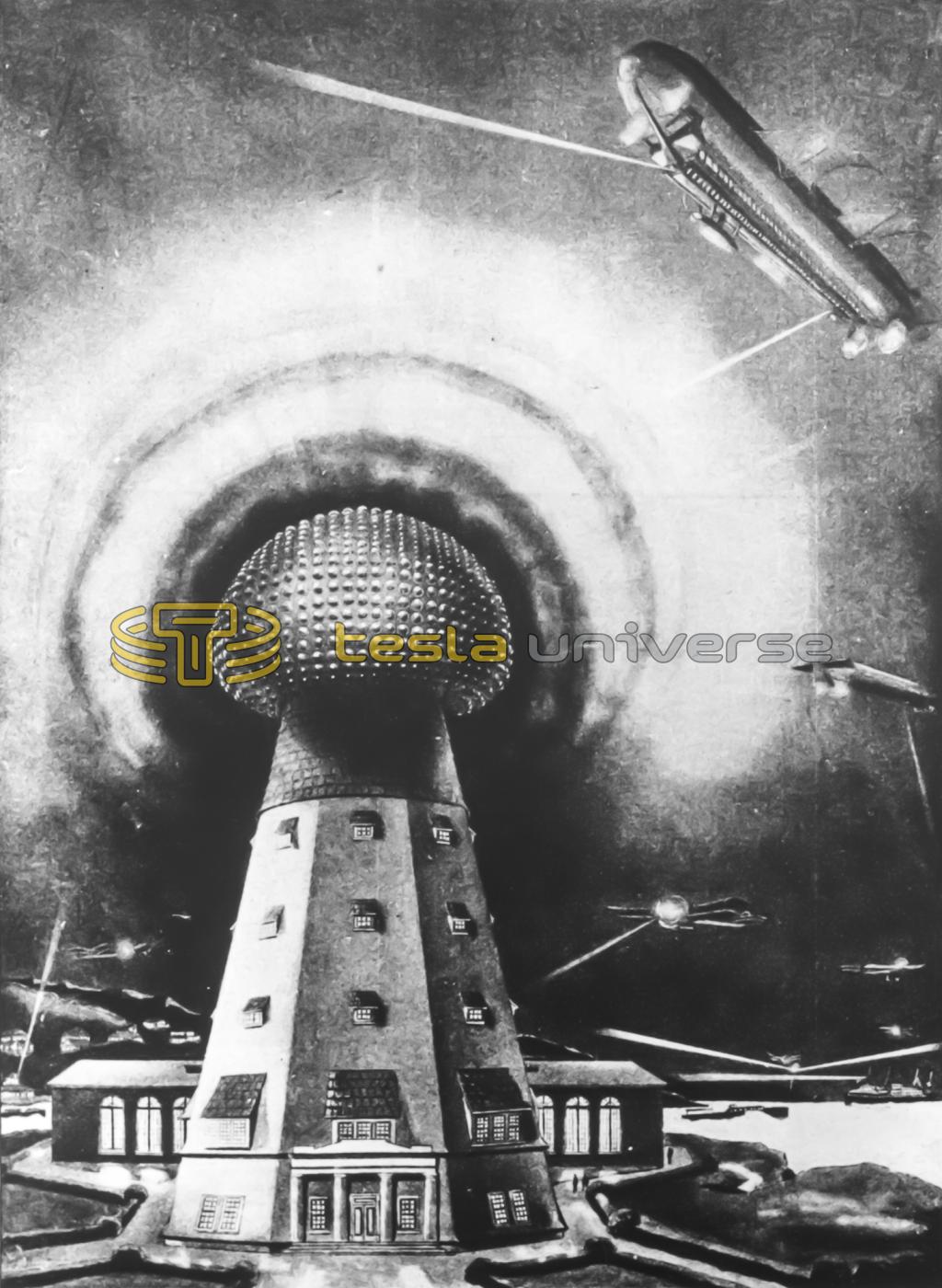
Nikola Tesla Articles
Tesla's Tower - Wardenclyffe
(We dedicate this article in memory of John Ratzlaff and his wife, Mildred, whose kindness and open sharing have helped so many.)
Tesla’s Wardenclyffe Tower technology might have a direct application to electric spacecraft. At the turn of the century, Tesla received funding from J. Pierpont Morgan to build the tower which, Tesla initially stated, would merely transmit radio signals across the Atlantic. However, when Marconi preempted him in that accomplishment, Tesla confided that in Wardenclyffe he had also designed a worldwide, wireless transmitter of energy for boats, airplanes, and other machines. This article is the first in a series written to provide information about the tower, to speculate on its operation, and to encourage others to provide additional information.
In 1899, Tesla experimented with an antenna in Colorado Springs, a pole which held a 30 inch sphere. What he learned from his work in Colorado inspired a new design which later became the Shoreham, Long Island, the site used by Tesla to construct his Energy Transmitter. The RCA Radio Tower was built within 2 miles. Now, the Shoreham Nuclear Reactor and Brookhaven National Labs are also nearby.
Wardenclyffe Tower at Shoreham, Long Island. There Tesla erected a 187 foot tall wood pillar. It held a 67 1/2 foot diameter ball on top and appeared to be a giant mushroom. Begun in 1901, the tower was nearly completed in 1903 when J.P. Morgan withdrew his financial support. The tower remained a skeleton (see Figure 1) until it was torn down in 1917. From then on, Tesla’s ideas and activities were shrouded in silence.
Operation of the Tower
In discussing the Wardenclyffe design, it will be helpful to review the supposed operation of the tower. Tesla had thoughts of earth electrical resonance as early as 1893. (1) The Colorado Springs Laboratory of 1899 was subsequently designed to perform definitive experiments:
- to develop a transmitter of great power;
- to perfect the means for individualizing and isolating the energy transmitted; and
- to ascertain the law of propagation of currents through the earth and the atmosphere.
By studying the periodicity of lightning beats at Colorado Springs, (see Figure 2), Tesla uncovered a phenomenon he called earth resonance. Indeed, there is some evidence that lightning is capable of producing earth resonance as Tesla described it. He explained that electrical impulses of sufficient magnitude travel longitudinally through the earth to the antipode and are reflected back. Mainstream scientists did not accept Tesla’s concept of longitudinal electric waves, and this is still very much the situation today.
In addition to discovering that the earth could resonate and carry electrical impulses, Tesla had learned years earlier that air, normally a good insulator, becomes an excellent conductor at high frequencies and voltages if reduced to about 75 mmHg. These facts indicated that the earth and its upper atmosphere could comprise a giant capacitor for high-voltage currents.
In order to utilize the earth-air capacitor, however, it seemed an antenna fifteen miles high was needed to connect to the upper air conducting layer. Tesla resolved this difficulty after further experimentation led to the development of a means of producing voltages three to four times greater than those previously created. Such electric forces, Tesla discovered, were capable of carrying current through much denser air.
Tesla was granted Patent #645,576, (filed in September, 1897), which acknowledged the feasibility of using lower atmospheric strata to conduct currents. The height of the transmitting towers need only be considerably taller than nearby structures to avoid unwanted discharges.
Tesla planned to apply his idea of earth electrical resonance to send electric power freely worldwide. Antennas placed anywhere would be tuned to receive the transmitted energy. The resonating longitudinal electrical impulses were to be transmitted through the conducting earth and atmospheric strata. To accomplish this Tesla knew he needed to create a substantial oscillation.
Wardenclyffe was to be the oscillator, but Tesla insisted the resonant waves it was to transmit were longitudinal, not Hertzian. (Current scientific thinking utilizes the concept of Hertzian waves in the form of Schumann resonance.) Wardenclyffe was to generate and send electric pulses to its dipoles, one of which was the top air terminal and the other, planet Earth. (See Figure 3.)
Evolution of the Tower Design
A series of Tesla patents, filed during the period 1897 to 1902, dealt directly with tower design. Tesla already knew what he wanted to learn at Colorado Springs with conditions of high altitude, rarified air, and isolation. Strong electrical discharges would be produced. Since Wardenclyffe was built at sea level, in moist salt air and next to New York City, it is also evident that Tesla decided that the Colorado Springs environment was no longer necessary. The ground at Shoreham is next to the sea and about 150 feet above sea level. Geologically it is a cretaceous clay structure on top of bedrock. Most of Long Island is only about 40 feet above sea level with a salt air environment.
Tesla obtained a patent to cover his new tower design in 1914. However, he had filed for this patent in 1902, with a renewal in 1907. This patent (#1,119,732) is shown in Figure 4.
It is interesting now to look at some of the words expressed directly by Tesla in his patents and writing. His Patent #649,621 filed February 19, 1900 (an extension of his 1897 Patent #645,576) simply stated:
...oscillations are produced.. .to be propagated by conduction through the natural medium...
...a coil, generally of many turns and of a very large diameter, wound in a spiral form... [this was the secondary of his oscillators] to produce a current of excessively high potential.. .of considerable frequency...where the atmosphere is rarefied...the current...will be transmitted with even less resistance than through an ordinary conductor.
...the transmission of electrical energy is one of true conduction and is not to be confounded with the phenomenon of electrical [Hertzian] radiation...
On May 16, 1900, Tesla filed for Patent #787,412 and further stated:
...powerful electrical oscillations communicated to the ground ... cause vibrations to be propagated to distant parts of the globe, whence they are reflected and by interference with outgoing vibrations produce stationary waves the crests and hollows of which lie in parallel circles....the planet behaves like a perfectly smooth or polished conductor......transmitting slow electrical oscillations without sensible distortion and attenuation.
...to establish the resonating condition...the earth’s diameter should be an odd multiple of the quarter wavelength.
...employ oscillations in which the rate of radiation of energy into space in the form of Hertzian or electromagnetic waves is very small.
...I would say the frequency should be less than twenty thousand per second, though shorter waves [higher frequencies] might be practicable...
...the wave train [frequency pulse] should continue for a certain interval of time...not less than...0.08484 of a second...which is taken in passing to and returning from the region diametrically opposite the [transmitter] pole...
It is worth noting that .08484 seconds is the time it takes to travel across the diameter of the earth and back at the speed of light.
Wardenclyffe Design Specifics
Certain reference material on Wardenclyffe is hard to find. We present a fraction of it here in order to convey essential points. Details are available in the publications cited. (ESJ has many reference works that are available to researchers.)
Both Leland Anderson and Dr. James Corum state that the tower sat over a 12 foot square vertical shaft dug into the ground to a depth of 120 feet. The shaft also had “blackened” side tunnels (presumably near the bottom) which extended out radially. The shaft was also said to contain a telescoping tube which could reach to the ball 187 feet above. A spiral staircase extended to the bottom and instruments were installed.
Figure 5 shows schematically some of the features discussed by Leland Anderson in his 1968 Wardenclyffe article. (8)
The tower frame was constructed entirely of treated wooden beams. The upper circular platform also appears to have been constructed of wood. Anderson states that no ferrous connectors (bolts or plates) were used in any of the structure.
We surmise the “blackened” subterranean tunnels might be conducting ground connections. This assumption is based on a comment by Tesla in My Inventions. (7)
...one form of apparatus comprised four antennae. These were carefully calibrated to the same frequency and connected in multiple with the object of magnifying the action, in receiving from any direction. When I desired to ascertain the origin of the transmitted impulses, each diagonally situated pair was put in series with a primary coil energizing the detector circuit...By employing receivers connected to two points of the ground, as suggested by me long ago this trouble [interference of static] caused by the charged air, which is very serious in the structures as now built, is nullified...
Further elaboration of the “ground antenna” can be seen in the work of James Harris Rogers who thanked Tesla directly in a letter to him on January 13, 1919. Rogers had redeveloped the “ground current” receiver with cables buried radially outward under the ground. (4)
Private letters between John Ratzlaff and Charles Yost speculated further on the Tower operation:
(February 16, 1982 from C. Yost to J. Ratzlaff)
...It is my thought that all of the primary and secondary coils of the Long Island Tesla Tower were housed in the top electrode, the details in the electrode indicate as much. Furthermore, it is a short step from that design to the ‘free-floating’ design of a saucer shape. The construction here is proceeding in that direction...
(March 8, 1982 from J. Ratzlaff to C. Yost)
I was particularly struck by your comment that the primary and secondary coils were housed in the electrode at the Wardenclyffe installation. Not long ago I came to the conclusion that Tesla made a distinction between the Tesla coil and the magnifying transmitter, the latter being a spiral type coil, in all probability. At that time another friend made the same observation, and carried it a bit further by pointing out that it was an “upside down” coil, the elevated terminal serving the function of a ground, and the antenna located in tunnels in the ground.
[Editor’s note: Dr. Corum shared similar ideas in conversations at the 1984 Tesla Symposium.]
While the “upside down coil” is simple speculation, there is some reason to believe that the upper electrode may not have had a direct (metal conducting) connection to ground.
To quote further from My Inventions:
His [Tesla’s] short explanation shows that this [the extra or additional coil] is the output stage of his transmitter. The secondary of his transformer is not connected directly with the antenna: an additional coil is inserted between the secondary and the antenna in order to increase the potential of the antenna consisting of planes [surfaces] with large radii of curvature...the amplifier of the transmitter is the output stage connected with the secondary of Tesla’ s transformer.
What makes this description more interesting is that the phrase “not connected directly” makes all the connections ambiguous, especially since it is known that Tesla had been experimenting with X-ray tubes in his circuits at Colorado Springs. This is seen in the letters (2) between Tesla in Colorado and his manager, Mr. Scherff in New York. On December 9, 1899, Mr. Scherff sent Tesla a message by telegram:
...two double focus Roentgen tubes which were in the laboratory have been expressed at once. However, as we are not quite sure that these are what is wanted, as the telegram says ‘thick platinum,’ two more tubes with extra thick platinum targets have been ordered... for shipment on Monday.
On December 12, 1899, Tesla sent a telegram to Mr. Scherff:
I shall soon return to the city [New York] with glorious results.... make arrangements for making up more tubes as those we have in stock....I shall want a good many of them.
December 19, 1899, to Tesla:
“...Alfred is working in the glass blowing room with great enthusiasm.”
Figure 6
Perhaps Tesla had found a way to make conductive connections between the secondary and extra coil by means of X-ray switching. However, a question comes to mind. Why were so many tubes required? The answer may reside in the design of the outer electrode. It consisted of a multitude of “spherical cups” placed over its surface. Patent #1,119,732 specifically talks about the upper electrode and the “cups” placed on its surface. To quote:
...a circuit with a large capacity behaves like a slack spring, whereas one with a small capacity acts like a stiff spring, vibrating more vigorously.
...to develop the greatest energy...I employ a terminal of relatively small capacity...to as high a pressure [voltage] as possible.
...I have found it imperative.. .that its [the upper electrode] outer surface...has itself a large radius of curvature, or is composed of separate elements which [cups]...are arranged in close proximity to each other and so, that the outside ideal surface enveloping them is of large radius.
...the smaller the radius of curvature [of the cups] the greater...will be the surface-density [electric field intensity].... Consequently, the lower the limiting [voltage] to which the terminal may be charged without electricity escaping to the air.
Figure 7. - Two Views of the Tesla Tower construction
The terminal [upper electrode],...covered with half spherical [cups], ...thus constituting a very large conducting surface, smooth on all places where the electric charge principally accumulates [negating the effect of the cups’ small radius of curvature].
Tesla had designed an upper electrode with a 34 foot radius which would develop a relatively large capacity and voltage if smooth. He then put “cups” all over its surface, of perhaps a 6 inch or one foot radius, which were supposed to reduce the effective capacity of the electrode in order to achieve more intense electrical vibrations. (See Figure 8.) It would seem that the surface area is increased as a result of the cups, and therefore that the overall capacity increases. Each cup may have been distinctly insulated from the other and operated in parallel to achieve more rapid vibration.
Tesla never really said the cups were in electrical contact with the base on which they were placed, although that would be presumed. The finishing of the electrode surface and the manner of attaching the cups is not addressed in the available documentation.
As Tesla suggested, the electric intensity would be much higher on the small cup radii and as a result the air would become highly ionized around the entire upper electrode - conducting to air. The glow which Tesla had mentioned gradually spreading around the ball at Colorado Springs would thereby be accomplished at Wardenclyffe.
The “half spherical plates,” as Tesla called them in his patent may not have been spherical at all. A sketch from Tesla’s hand at the Tesla Museum in Belgrade shows the half spherical elements as deep parabolic shells (see Figure 9 ) and constructed of aluminum.
The parabolic shape would surpass the hemispheric in increasing electric field intensity. Sharper curves than that of a parabola would also cause an increase. Our speculation is that parabolic shells were chosen for focusing and projecting. Tesla’s first discoveries in high voltage and high frequency began with light bulbs in 1890. From there the line of experiments extended in a progression to the single element X-ray bulb. Perhaps the parabolic cups somehow incorporated X-ray tube technology for transferring electrical energy between the upper electrode, coils, and the ground terminal.*
Summation
In spite of enormous effort, there is very little known about Tesla’s tower for the transmission of energy. Tesla was simply removed from the textbooks. He envisioned the electric propulsion of aircraft, communications with Mars, and much more. What remains is the photograph of a skeleton.
To be continued...
Credits: Parts of pictures that appeared in:
- Electrical Experimenter Magazine, June,1919. Hugo Gernsback, Pres. (1884-1967) He also founded the currently published magazine Radio-Electronics.
- My Inventions, a book published in Yugoslavia, (1977), by Skolska Knjiga Publishing Enterprise of Zagreb.
References
Books
(1) O’Neill, John J., Prodigal Genius: The Life of Nikola Tesla, Ives Washburn, Inc., 1944,1964.
(2) Ratzlaff, John T. and Fred A. Jost, Dr. Nikola Tesla, Tesla Book Company, 2521 Palma Drive, Ventura, California 93003. 1979. Compilation of English/Serbo-Croatian Diary Comparisons; Serbo-Croatian Diary Commentary; Tesla/Scherff Colorado Springs Correspondence.
(3) Ratzlaff, John T., Reference Articles for Solutions to Tesla’s Secrets. Tesla Book Company, 2521 Palma Drive, Ventura, California 93003. 1981.
(4) Ratzlaff, John T., Tesla Said, Tesla Book Company, 2521 Palma Drive, Ventura, California 93003. 1984.
(5) Nikola Tesla, Colorado Springs Notes, 1899-1900, prepared for publication by the Nikola Tesla Museum, Beograd, published by Nolit, Beograd, Yugoslavia, 1978.
(6) Nikola Tesla, Lectures, Patents, Articles, compiled and published by the Nikola Tesla Museum, Beograd, Yugoslavia, 1956.
(7) Valic, Branimira, Editor. My Inventions by Nikola Tesla, Zagreb, 1977. This is a compilation by the Nikola Tesla Museum in Belgrade and the Yugoslav Academy of Arts and Science of the pictorial and text material from the article “My Inventions” by N. Tesla, published in the Electrical Experimenter in 1919.
Articles
(8) Anderson, Leland I., “Wardenclyffe--A Forfeited Dream” by Long Island Forum, PO Box 215, West Islip, NY, Aug., Sept., 1968, reprint.
(9) Armagnac, Alden P., “A Famous Prophet of Science Looks into the Future,” Popular Science Monthly, November 1928, page 16.
(10) Corum, J.F. and K.L. Corum, “A Physical Interpretation of the Colorado Springs Data,” Proceedings of the 1st International Tesla Symposium, Colorado Springs, Colorado, 1985.
(11) Corum, J.F. and K.L. Corum, “A Technical Analysis of the Extra Coil As A Slow Wave Helical Resonator,” Proceedings of the 2nd International Tesla Symposium, Colorado Springs, Colorado, 1986.
(12) Corum, J.F. and K.L. Corum, “Critical Speculations Concerning Tesla’s Invention and Applications of Single Electrode X-Ray Directed Discharges for Power Processing, Terrestrial Resonances, and Particle Beam Weapons,” Ibid.
(13) Corum, J.F. and K.L. Corum, “Disclosures Concerning the Operation of an ELF Oscillator,” Proceedings of the 1st International Tesla Symposium, Colorado Springs, Colorado, 1985.
(14) Corum, J.F. and K.L. Corum, “The Transient Propagation of ELF Pulses in the Earth-Ionosphere Cavity,” Proceedings of the 2nd International Tesla Symposium, Colorado Springs, Colorado, 1986.
(15) Hunt, Inez and Leland Anderson, “Lightning over ‘Little London,’” Empire Magazine, July 11, 1976, p. 16.
(16) Marincic, A.S. “Nikola Tesla and the Wireless Transmission of Energy” Belgrade, Yugoslavia, IEEE Transactions on Power Apparatus and Systems, Vol.PAS-101, No. 10, October 1982.
(17) Quinby, Commander E.J., USN (Ret.), “Nikola Tesla, World’s Greatest Engineer” [No further documentation available; date is probably 1971.]
(18) Tesla, Nikola. “How the Electrician’s Lamp of Aladdin May Construct New Worlds,” Letter to the Editor, New York Times, April 21, 1908.
(19) Tesla, Nikola. “Nikola Tesla’s Plan to Keep ‘Wireless Thumb’ on Ships at Sea,” New York Press, November 9, 1913.
(20) Time Magazine, “Tesla at 75,” July 20, 1931, page 27.
Some of the best contemporary references on Tesla and Wardenclyffe Tower technology are:
1. Dr. James Corum and Kenneth Corum, perhaps the best, who have done detailed electrical investigations for many years.
2. Leland Anderson, who has much of the unpublished historical detail and contacts.
3. The Tesla Book Company (founded by the late John Ratzlaff) which continues to publish one of the best Tesla collections available.
4. The International Tesla Society, with its collection of people and resources.
5. Toby Grotz, who has been involved with Tesla Tower research on an experimental level.
6. Ron Kovac, who has been doing experiments along the lines Tesla explained.
